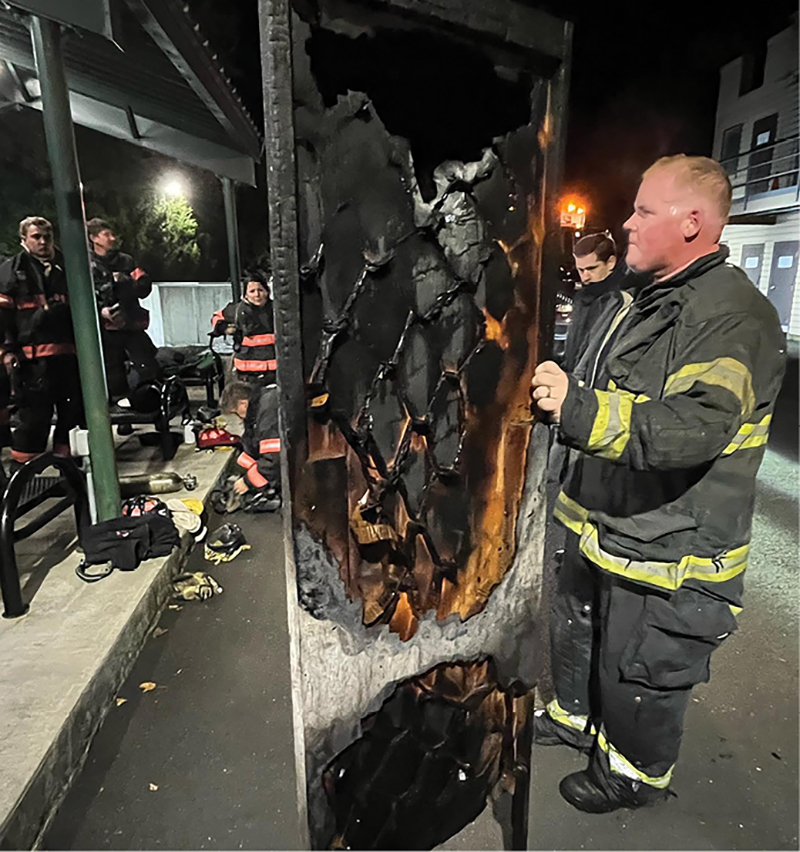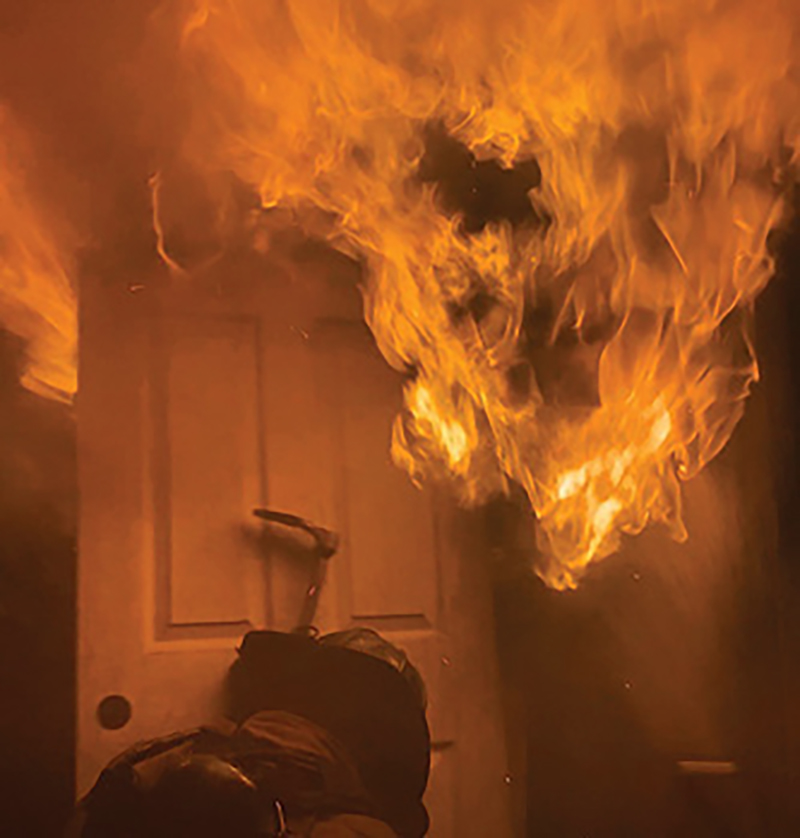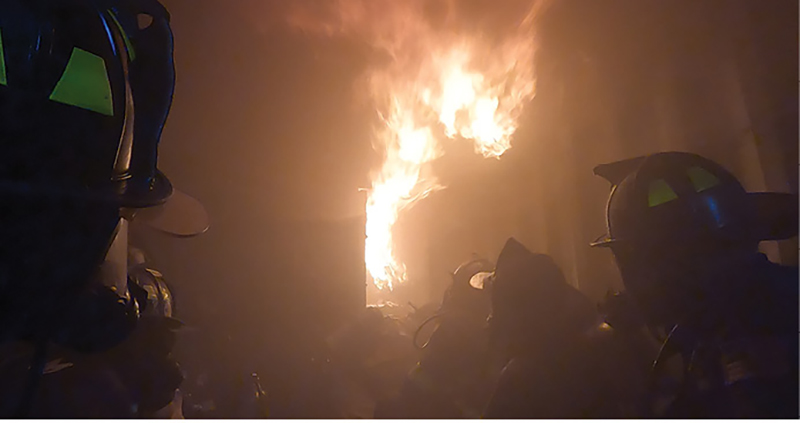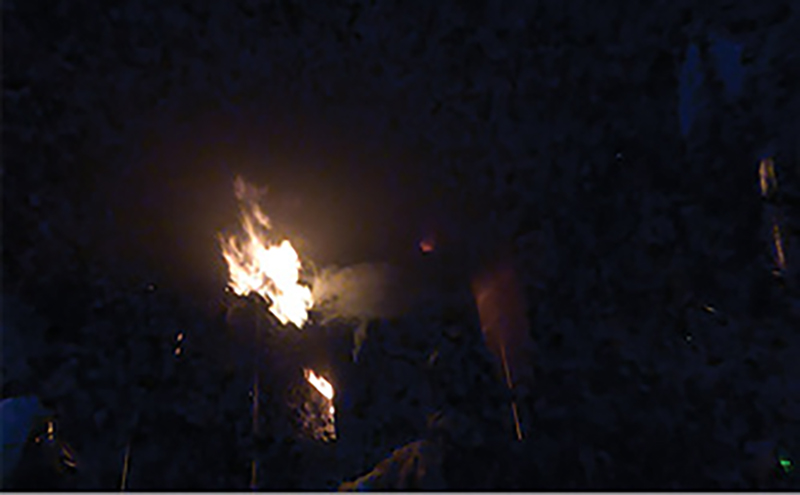By Daniel Gordon
In many fire departments, it can be taboo or even formally forbidden to operate “without the protection of a hoseline.” However, for many, this is the reality on a daily basis. For others, it may be a situation with which they are rarely confronted.
- Essential Hoseline Management for the Rapid Intervention Team
- Operating Ahead of the Handline: Locate, Confine, Control
- The Engine Company-Based Search
- Searching Off a Hoseline–A Necessary Risk?
When asked why they can’t do it, many say they are told, “It is too dangerous” or “There is nothing to gain.” The other common phrase is, “If you put the fire out, all your other problems go away.” While this may be true for the firefighters, I wholeheartedly disagree with this statement as it pertains to civilian victims trapped inside the structure. If it’s true that ALL the problems go away, why do we continue to wear our self-contained breathing apparatus (SCBA) and measure toxic levels of various deadly gases in the structure after the fire is knocked down? While nothing should delay water application, we must simultaneously, and even sometimes first, conduct an aggressive search for civilian life. As with many actions on the fireground, operating without a hoseline is not something we should always do, but it should be something we are prepared to do. Before we discuss how to prepare for operating without a hoseline, we must define what that entails.

1. Even a hollow core door is able to hold back a tremendous amount of fire for a period of time. All photos were taken inside of Flash Fire Industries’ custom-built flashover/fire behavior container. (Photos by Matt Van Ness, MV Film Productions.)
Definition of Operating Without a Hoseline
I define operating without a hoseline as operating without the ability to be immediately protected by a hoseline that is flowing a sufficient number of gallons per minute (gpm) to adequately cool the environment, change fire conditions, and allow the continued operation of personnel in the fire environment. Let’s break this down.
If the hoseline is not near us, it cannot protect us. Let’s use the example of a two-story private dwelling with a fire on the first floor and crews searching the second floor for potential victims. If we are operating in the rear of the second floor and there is only one hoseline stretched into the first floor, then we are not protected. Should we find hidden fire, fire coming up behind us, autoexposure from the floor below, or conditions suddenly changing, we would be faced with a serious situation if we are not able to isolate ourselves. Once a second line is stretched to the second floor and able to immediately apply water to the area, we are now protected by a hoseline and can change our actions accordingly.
Repositioning a hoseline must be communicated and acknowledged, particularly by a crew who may be losing the protection of that line. In the above example, if the line on the first floor suffered a burst length and no third line was initially available, the second line may be brought down to the first floor to take over the fire attack. If this is the case, the crew searching on the second floor must be notified and verbally acknowledge the loss of their protection. In this scenario, they went from being protected by a hoseline to not. While they will most likely still continue their search, their mindset must shift knowing they lost that protection.

2. A firefighter prepares to use the pressurized water extinguisher.

3. A firefighter uses the pike of the halligan to place a door in front of an uncontrolled fire.

4. The can used in conjunction with a door to hold back fire.
Water puts out fire. Nothing should delay getting water on the fire. However, insufficient water will not adequately cool the environment, prevent flashover, or protect crews working inside to conduct searches. If the hoseline being operated is not adequately cooling, then the members performing searches are not truly protected by the hoseline. The hoseline is meant to cool the environment and extinguish the fire. If these goals are not met, then searches cannot continue. While this may seem like an obvious statement, I have seen inadequate streams and inadequate hoselines for the volume of fire visible try to protect members operating without a hoseline. Ensure you are pumping your hose and nozzles adequately, chasing kinks, and using the correct size hose for the amount of fire encountered.
The Circumstances
Why would we find ourselves in the position of operating without a hoseline? Let’s look at some circumstances where this could happen.
Type of responding apparatus. You may be responding in anything from a pickup truck to a ladder or heavy rescue apparatus. Also keep in mind that many departments are beginning to or are currently operating ambulances staffed by firefighters with gear and SCBA. This is sometimes an overlooked “apparatus” that does not have water and it could very well be first on scene because of its proximity to a previous run.
Long or delayed hose stretches. Not every hoseline stretched will be the 200-foot preconnect with the private dwelling 25 to 50 feet off the road. It is important for both the engine company as well as other companies to identify if a long hose stretch will be required as part of their size-up. The engines obviously need to know so they can ensure they stretch enough hose, but the other crews must be aware as well so they are prepared for a delay in water application and can plan accordingly. Since there is no set definition of what a “long stretch” would be, it’s based on your department, your standard preconnects, and the types of buildings in your response area. However, if you take a preconnect and disconnect it to add additional lengths at an incident, there is no doubt that this would lead to some level of a delay in water application.
Standpipes. Regardless of your department’s frequency of responding to standpipe-equipped buildings, you should be prepared for delays anytime standpipes are involved. Between finding the correct siamese; troubleshooting standpipe issues (frozen siamese, missing hand-wheel, burred threads); and getting sufficient hose to the fire floor flaked out, charged, and pressure set, there is undoubtedly the high chance for something, even minor, to delay getting water on the fire. In addition, calls for smoke on multiple floors may delay locating the fire.
Elevators are also a major factor. Properly controlled and operating, the elevators will make travel to upper floors much more efficient. Out-of-service elevators will require ascending the stairs and will obviously impact reaction time accordingly.



5., 6., & 7. An uncontrolled fire is venting out of the flashover area. A door is placed over the opening. More than six minutes later, the fire is still relatively controlled even though the door is starting to show signs of failure.
Finding the fire. Not every fire will present itself on your arrival. Water must be applied directly to the seat of the fire and can only be done if the fire is found. While in smaller private dwellings this may not be a huge issue, larger private dwellings, multiple dwellings, and commercial occupancies could present challenges for determining fire location. While this may sound like a simple task, it is very difficult for an engine company to “stand fast” while the fire is being located. Depending on the size of the building and number of access points, there may be a more desirable entrance to use for fire attack. It is incumbent, at times, for the hoseline to not overcommit to a point where it cannot be repositioned if needed while the fire is located.
Hoseline issues. As the incident progresses, hoseline issues can occur for a variety of reasons. Members operating must be in tune with the radio to be aware of any issues that arise and change of hoseline status. Some examples include a burst length, excessive kinks, short stretches, engine issues, and loss of water. Burst lengths can cause a rapid loss of water. However, at times, the burst is minor and the hoseline can continue to operate while a backup hoseline is stretched. Removing kinks should be every firefighter’s job on the fireground. No one should walk past kinks; you must communicate excessive kinks, hose caught under doors, or kinks that are unable to be cleared.
All companies should have a way to remedy a short stretch. Depending on your setup, this could be adding a length to the front of the stretch or the rear of the stretch. With breakaway nozzles, this may not even require shutting the line down at the pump panel.
Communication. For all the size-ups and preplans that can be performed, there is nothing more important than proper communication on the fireground. This may seem like an obvious statement; however, firehouse culture and firehouse pride sometimes get in the way of communication when things “aren’t going well.” The hydrant firefighter may struggle with the hydrant and tell himself: “Just one more minute; I’ll get it.” Meanwhile, there are members operating inside off of tank water. The member at the standpipe may be having trouble getting the standpipe open. Perhaps the hose was not properly flaked out and is now caught under the door. The roof firefighter may be delayed getting to the roof because of a hoarding condition in the hallway of the adjoining building. Or maybe the search crew is having trouble locating the fire while the engine company is itching to get in and put it out. All of these, and more, are issues that WILL happen on the fireground. It is not a question of if they will happen but when and how you will react to them.
Communicate all these situations to everyone on the fireground. While it may be embarrassing to admit that you made a mistake or that your operation is not going as planned, it is imperative that everyone else on the fireground relying on your position is aware. If I am performing a search and I hear that there are issues with the standpipe, I am able to throttle my operation back, knowing that there may be an extended delay in getting water. One of my assumptions with my crew is if I hear nothing, it means things are going as planned. So, it is absolutely imperative that any delays be communicated promptly. Additionally, the incident commander (IC) should ensure that if there is a delay that affects a specific unit, that unit is made aware. For example, the engine officer may report that members have stretched short and are working on adding a length but will be delayed. If there is a company operating inside without a hoseline, they must be contacted specifically and confirm receipt of this report. While all members on the fireground should be aware of this delay, the crew awaiting that hoseline MUST be specifically informed.
Equipment
For members who may find themselves operating without a hoseline, there are a few helpful pieces of equipment.
The can. The pressurized water extinguisher or “the can” is not a replacement for a hoseline. This is 2½ gallons that, if properly filled, will last roughly 50 seconds. Depending on the stage of the fire, the pressure behind it, and the overall temperatures of the environment, the can will provide a variety of results. The purpose of the can for a fire beyond the incipient stage is NOT to extinguish the fire. Any water put directly into the fire compartment is a waste and will immediately evaporate. The can would be used to allow isolation (closing a door), prolong isolation (cooling the back of the door and knocking down any fire that is coming around it), allow emergency escape, or allow a search team to bypass the fire to perform a search (generally reserved for known life hazard situations).
It is important to not have too many expectations of what the can is able to do. The can is not going to eliminate conditions like a hoseline will. However, the can, particularly when coupled with isolation of the fire, will have a tremendous impact on the fireground while you await a hoseline.
The door. Isolating with doors is nothing new in the fire service. Over the past few years, data has shown what firefighters have known for decades: Doors hold back a tremendous amount of fire! In multiple dwellings, many times this will be the main entrance door to the apartment that can be isolated to prevent fire from extending into the public hallway. In private dwellings, and once you enter the apartment of a multiple dwelling, the emphasis should be on isolating the fire to the room of origin if possible. Generally, this will only be possible when the fire is in a bedroom or bathroom. Most kitchens and living rooms have open areas that do not have doors to allow for isolation. In this case, controlling the front door or main apartment entrance door may be possible to reduce the amount of oxygen that can be drawn toward the fire.
In many multiple dwellings, the kitchen may be set off to the side near the entrance with a doorframe type entrance but no door. If this is the case, you can force a door from a nearby closet or bathroom off its hinges and place it over this opening to the kitchen. If the door does not fit exactly, that is okay. Simply use short bursts of the can around the door and intermittently cool the backside of the door to prolong its integrity. Some firefighters will place a gloved finger over the tip of the can’s nozzle to get a fan pattern to hit more surface area when cooling the door.
It is important to remember that no door should be completely closed if possible. Placing a tool or throwing the deadbolt avoids the door locking. While a door locking could be a nuisance for the crew attempting to make entry, it could be downright deadly for the crew inside who needs to escape in a hurry.
Search rope. Search ropes come in a few shapes and sizes. I hesitate to call them “search” ropes because I use them more as orientation ropes. When a search rope gets deployed, it is a lifeline to get out while attempting to locate the fire in a large or oddly laid out building. If there is no hoseline present yet, or it is not yet known where that hoseline should be stretched, the search rope may be the best avenue for orientation and hasty retreat if necessary.
It is critical that the end of the search rope, where the carabiner is, be labeled with the company designation. If multiple ropes are deployed and either a Mayday is called or one of the companies finds the fire, other companies must be able to identify which rope to follow.
The search rope, aside from being used as “your way out,” can be used to identify the path for the engine to take as well as distance. Most search ropes have some marking system to indicate distance. This can ensure the engine has enough hoseline for the stretch and can navigate effectively to the seat of the fire. In most commercial occupancies with unusual layouts and larger areas, the emphasis should be to find the fire, extinguish the fire, and ventilate the building rapidly. It is not practical to expect to search a large commercial structure with the same efficiency as a private dwelling.
While “operating without a hoseline” is not a tactic that will occur every day, firefighters must be prepared to do so. The most important size-up factor is recognizing that you are, in fact, not currently protected by a hoseline. Your situational awareness of your surroundings must be fluid throughout the incident. You may have a hoseline with you one minute and, as it is repositioned or you reposition, the next minute you do not. Communication between companies and with the IC is essential to be aware of issues and problems. Isolation of oxygen, until copious amounts of water are being applied, is our friend. This isolation can either be at the main entrance or, even better, isolating the fire to the room of origin. As an important reminder, nothing should delay getting our hoselines into position and getting water onto the fire. So goes the first line, so goes the fire.
Daniel Gordon began his fire service career at age 15 as a junior firefighter with the Trumbull Center (CT) Fire Department. He was hired by the Fire Department of New York in 2008, where he was assigned to Ladder 47, followed by Squad 61. He is assigned to Ladder 2. He also owns and operates Flash Fire Industries, a mobile fire training and fabrication company.
Daniel Gordon will present “Without the Protection of a Hoseline: The Uncomfortable Reality” at FDIC International in Indianapolis, Indiana, on Thursday, April 18, 2024, 10:30 a.m.-12:15 p.m.

